Zhan Zhao
Analyzing sequential activity and travel decisions with interpretable deep inverse reinforcement learning
Mar 17, 2025Abstract:Travel demand modeling has shifted from aggregated trip-based models to behavior-oriented activity-based models because daily trips are essentially driven by human activities. To analyze the sequential activity-travel decisions, deep inverse reinforcement learning (DIRL) has proven effective in learning the decision mechanisms by approximating a reward function to represent preferences and a policy function to replicate observed behavior using deep neural networks (DNNs). However, most existing research has focused on using DIRL to enhance only prediction accuracy, with limited exploration into interpreting the underlying decision mechanisms guiding sequential decision-making. To address this gap, we introduce an interpretable DIRL framework for analyzing activity-travel decision processes, bridging the gap between data-driven machine learning and theory-driven behavioral models. Our proposed framework adapts an adversarial IRL approach to infer the reward and policy functions of activity-travel behavior. The policy function is interpreted through a surrogate interpretable model based on choice probabilities from the policy function, while the reward function is interpreted by deriving both short-term rewards and long-term returns for various activity-travel patterns. Our analysis of real-world travel survey data reveals promising results in two key areas: (i) behavioral pattern insights from the policy function, highlighting critical factors in decision-making and variations among socio-demographic groups, and (ii) behavioral preference insights from the reward function, indicating the utility individuals gain from specific activity sequences.
Sparkle: Mastering Basic Spatial Capabilities in Vision Language Models Elicits Generalization to Composite Spatial Reasoning
Oct 21, 2024Abstract:Vision language models (VLMs) have demonstrated impressive performance across a wide range of downstream tasks. However, their proficiency in spatial reasoning remains limited, despite its crucial role in tasks involving navigation and interaction with physical environments. Specifically, much of the spatial reasoning in these tasks occurs in two-dimensional (2D) environments, and our evaluation reveals that state-of-the-art VLMs frequently generate implausible and incorrect responses to composite spatial reasoning problems, including simple pathfinding tasks that humans can solve effortlessly at a glance. To address this, we explore an effective approach to enhance 2D spatial reasoning within VLMs by training the model on basic spatial capabilities. We begin by disentangling the key components of 2D spatial reasoning: direction comprehension, distance estimation, and localization. Our central hypothesis is that mastering these basic spatial capabilities can significantly enhance a model's performance on composite spatial tasks requiring advanced spatial understanding and combinatorial problem-solving. To investigate this hypothesis, we introduce Sparkle, a framework that fine-tunes VLMs on these three basic spatial capabilities by synthetic data generation and targeted supervision to form an instruction dataset for each capability. Our experiments demonstrate that VLMs fine-tuned with Sparkle achieve significant performance gains, not only in the basic tasks themselves but also in generalizing to composite and out-of-distribution spatial reasoning tasks (e.g., improving from 13.5% to 40.0% on the shortest path problem). These findings underscore the effectiveness of mastering basic spatial capabilities in enhancing composite spatial problem-solving, offering insights for improving VLMs' spatial reasoning capabilities.
Synergizing Spatial Optimization with Large Language Models for Open-Domain Urban Itinerary Planning
Feb 11, 2024Abstract:In this paper, we for the first time propose the task of Open-domain Urban Itinerary Planning (OUIP) for citywalk, which directly generates itineraries based on users' requests described in natural language. OUIP is different from conventional itinerary planning, which limits users from expressing more detailed needs and hinders true personalization. Recently, large language models (LLMs) have shown potential in handling diverse tasks. However, due to non-real-time information, incomplete knowledge, and insufficient spatial awareness, they are unable to independently deliver a satisfactory user experience in OUIP. Given this, we present ItiNera, an OUIP system that synergizes spatial optimization with Large Language Models (LLMs) to provide services that customize urban itineraries based on users' needs. Specifically, we develop an LLM-based pipeline for extracting and updating POI features to create a user-owned personalized POI database. For each user request, we leverage LLM in cooperation with an embedding-based module for retrieving candidate POIs from the user's POI database. Then, a spatial optimization module is used to order these POIs, followed by LLM crafting a personalized, spatially coherent itinerary. To the best of our knowledge, this study marks the first integration of LLMs to innovate itinerary planning solutions. Extensive experiments on offline datasets and online subjective evaluation have demonstrated the capacities of our system to deliver more responsive and spatially coherent itineraries than current LLM-based solutions. Our system has been deployed in production at the TuTu online travel service and has attracted thousands of users for their urban travel planning.
Exploring Large Language Models for Human Mobility Prediction under Public Events
Nov 29, 2023Abstract:Public events, such as concerts and sports games, can be major attractors for large crowds, leading to irregular surges in travel demand. Accurate human mobility prediction for public events is thus crucial for event planning as well as traffic or crowd management. While rich textual descriptions about public events are commonly available from online sources, it is challenging to encode such information in statistical or machine learning models. Existing methods are generally limited in incorporating textual information, handling data sparsity, or providing rationales for their predictions. To address these challenges, we introduce a framework for human mobility prediction under public events (LLM-MPE) based on Large Language Models (LLMs), leveraging their unprecedented ability to process textual data, learn from minimal examples, and generate human-readable explanations. Specifically, LLM-MPE first transforms raw, unstructured event descriptions from online sources into a standardized format, and then segments historical mobility data into regular and event-related components. A prompting strategy is designed to direct LLMs in making and rationalizing demand predictions considering historical mobility and event features. A case study is conducted for Barclays Center in New York City, based on publicly available event information and taxi trip data. Results show that LLM-MPE surpasses traditional models, particularly on event days, with textual data significantly enhancing its accuracy. Furthermore, LLM-MPE offers interpretable insights into its predictions. Despite the great potential of LLMs, we also identify key challenges including misinformation and high costs that remain barriers to their broader adoption in large-scale human mobility analysis.
Deep trip generation with graph neural networks for bike sharing system expansion
Mar 20, 2023



Abstract:Bike sharing is emerging globally as an active, convenient, and sustainable mode of transportation. To plan successful bike-sharing systems (BSSs), many cities start from a small-scale pilot and gradually expand the system to cover more areas. For station-based BSSs, this means planning new stations based on existing ones over time, which requires prediction of the number of trips generated by these new stations across the whole system. Previous studies typically rely on relatively simple regression or machine learning models, which are limited in capturing complex spatial relationships. Despite the growing literature in deep learning methods for travel demand prediction, they are mostly developed for short-term prediction based on time series data, assuming no structural changes to the system. In this study, we focus on the trip generation problem for BSS expansion, and propose a graph neural network (GNN) approach to predicting the station-level demand based on multi-source urban built environment data. Specifically, it constructs multiple localized graphs centered on each target station and uses attention mechanisms to learn the correlation weights between stations. We further illustrate that the proposed approach can be regarded as a generalized spatial regression model, indicating the commonalities between spatial regression and GNNs. The model is evaluated based on realistic experiments using multi-year BSS data from New York City, and the results validate the superior performance of our approach compared to existing methods. We also demonstrate the interpretability of the model for uncovering the effects of built environment features and spatial interactions between stations, which can provide strategic guidance for BSS station location selection and capacity planning.
Adapting Node-Place Model to Predict and Monitor COVID-19 Footprints and Transmission Risks
Dec 31, 2022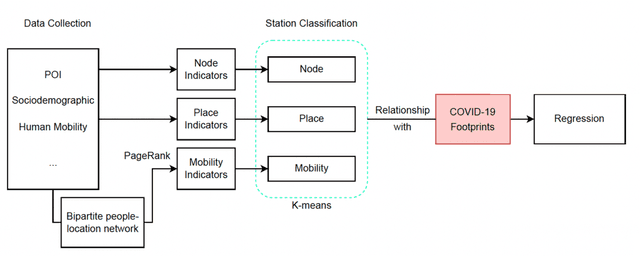

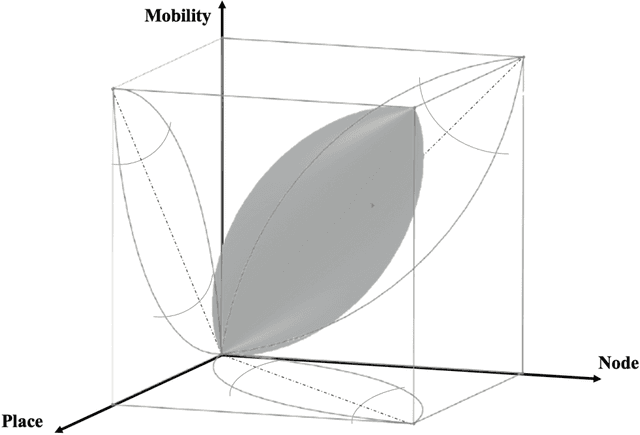
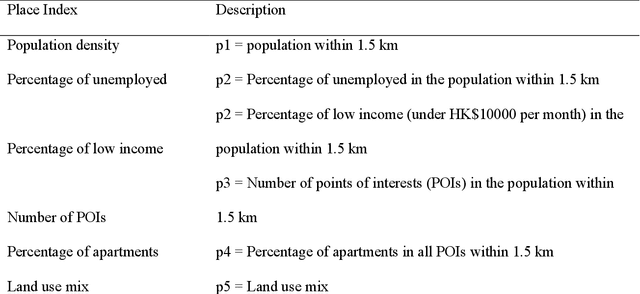
Abstract:The node-place model has been widely used to classify and evaluate transit stations, which sheds light on individual travel behaviors and supports urban planning through effectively integrating land use and transportation development. This article adapts this model to investigate whether and how node, place, and mobility would be associated with the transmission risks and presences of the local COVID-19 cases in a city. Similar studies on the model and its relevance to COVID-19, according to our knowledge, have not been undertaken before. Moreover, the unique metric drawn from detailed visit history of the infected, i.e., the COVID-19 footprints, is proposed and exploited. This study then empirically uses the adapted model to examine the station-level factors affecting the local COVID-19 footprints. The model accounts for traditional measures of the node and place as well as actual human mobility patterns associated with the node and place. It finds that stations with high node, place, and human mobility indices normally have more COVID-19 footprints in proximity. A multivariate regression is fitted to see whether and to what degree different indices and indicators can predict the COVID-19 footprints. The results indicate that many of the place, node, and human mobility indicators significantly impact the concentration of COVID-19 footprints. These are useful for policy-makers to predict and monitor hotspots for COVID-19 and other pandemics transmission.
Cross-Mode Knowledge Adaptation for Bike Sharing Demand Prediction using Domain-Adversarial Graph Neural Networks
Nov 16, 2022



Abstract:For bike sharing systems, demand prediction is crucial to ensure the timely re-balancing of available bikes according to predicted demand. Existing methods for bike sharing demand prediction are mostly based on its own historical demand variation, essentially regarding it as a closed system and neglecting the interaction between different transportation modes. This is particularly important for bike sharing because it is often used to complement travel through other modes (e.g., public transit). Despite some recent progress, no existing method is capable of leveraging spatiotemporal information from multiple modes and explicitly considers the distribution discrepancy between them, which can easily lead to negative transfer. To address these challenges, this study proposes a domain-adversarial multi-relational graph neural network (DA-MRGNN) for bike sharing demand prediction with multimodal historical data as input. A temporal adversarial adaptation network is introduced to extract shareable features from demand patterns of different modes. To capture correlations between spatial units across modes, we adapt a multi-relational graph neural network (MRGNN) considering both cross-mode similarity and difference. In addition, an explainable GNN technique is developed to understand how our proposed model makes predictions. Extensive experiments are conducted using real-world bike sharing, subway and ride-hailing data from New York City. The results demonstrate the superior performance of our proposed approach compared to existing methods and the effectiveness of different model components.
HGARN: Hierarchical Graph Attention Recurrent Network for Human Mobility Prediction
Oct 14, 2022



Abstract:Human mobility prediction is a fundamental task essential for various applications, including urban planning, transportation services, and location recommendation. Existing approaches often ignore activity information crucial for reasoning human preferences and routines, or adopt a simplified representation of the dependencies between time, activities and locations. To address these issues, we present Hierarchical Graph Attention Recurrent Network (HGARN) for human mobility prediction. Specifically, we construct a hierarchical graph based on all users' history mobility records and employ a Hierarchical Graph Attention Module to capture complex time-activity-location dependencies. This way, HGARN can learn representations with rich contextual semantics to model user preferences at the global level. We also propose a model-agnostic history-enhanced confidence (MaHec) label to focus our model on each user's individual-level preferences. Finally, we introduce a Recurrent Encoder-Decoder Module, which employs recurrent structures to jointly predict users' next activities (as an auxiliary task) and locations. For model evaluation, we test the performances of our Hgarn against existing SOTAs in recurring and explorative settings. The recurring setting focuses more on assessing models' capabilities to capture users' individual-level preferences. In contrast, the results in the explorative setting tend to reflect the power of different models to learn users' global-level preferences. Overall, our model outperforms other baselines significantly in the main, recurring, and explorative settings based on two real-world human mobility data benchmarks. Source codes of HGARN are available at https://github.com/YihongT/HGARN.
Deep Inverse Reinforcement Learning for Route Choice Modeling
Jun 18, 2022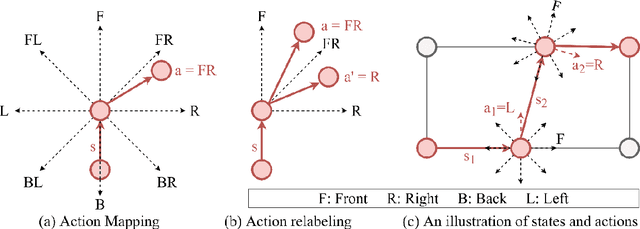

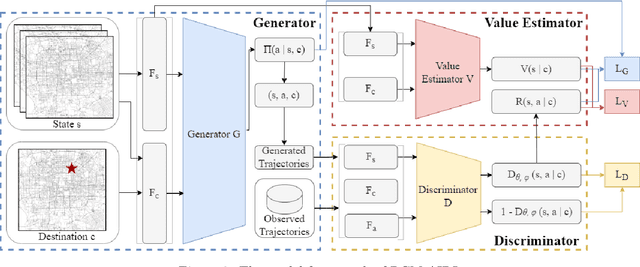

Abstract:Route choice modeling, i.e., the process of estimating the likely path that individuals follow during their journeys, is a fundamental task in transportation planning and demand forecasting. Classical methods generally adopt the discrete choice model (DCM) framework with linear utility functions and high-level route characteristics. While several recent studies have started to explore the applicability of deep learning for travel choice modeling, they are all path-based with relatively simple model architectures and cannot take advantage of detailed link-level features. Existing link-based models, while theoretically promising, are generally not as scalable or flexible enough to account for the destination characteristics. To address these issues, this study proposes a general deep inverse reinforcement learning (IRL) framework for link-based route choice modeling, which is capable of incorporating high-dimensional features and capturing complex relationships. Specifically, we adapt an adversarial IRL model to the route choice problem for efficient estimation of destination-dependent reward and policy functions. Experiment results based on taxi GPS data from Shanghai, China validate the improved performance of the proposed model over conventional DCMs and other imitation learning baselines, even for destinations unseen in the training data. We also demonstrate the model interpretability using explainable AI techniques. The proposed methodology provides a new direction for future development of route choice models. It is general and should be adaptable to other route choice problems across different modes and networks.
Bike Sharing Demand Prediction based on Knowledge Sharing across Modes: A Graph-based Deep Learning Approach
Mar 18, 2022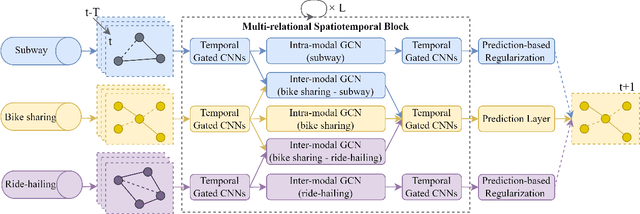
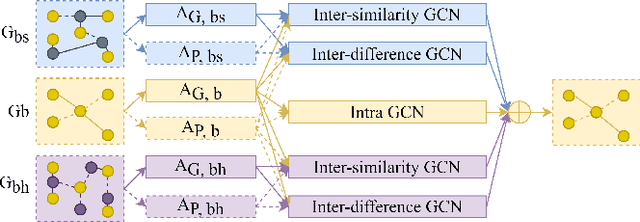
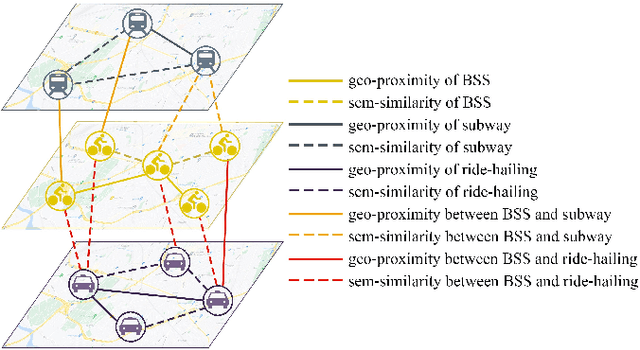
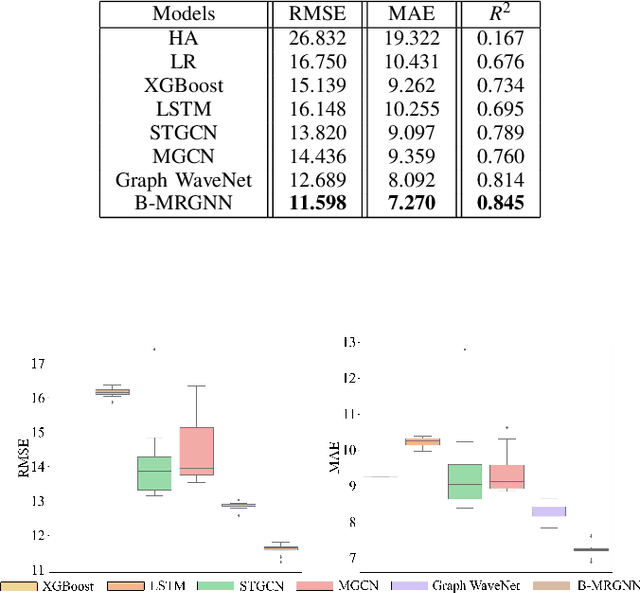
Abstract:Bike sharing is an increasingly popular part of urban transportation systems. Accurate demand prediction is the key to support timely re-balancing and ensure service efficiency. Most existing models of bike-sharing demand prediction are solely based on its own historical demand variation, essentially regarding bike sharing as a closed system and neglecting the interaction between different transport modes. This is particularly important because bike sharing is often used to complement travel through other modes (e.g., public transit). Despite some recent efforts, there is no existing method capable of leveraging spatiotemporal information from multiple modes with heterogeneous spatial units. To address this research gap, this study proposes a graph-based deep learning approach for bike sharing demand prediction (B-MRGNN) with multimodal historical data as input. The spatial dependencies across modes are encoded with multiple intra- and inter-modal graphs. A multi-relational graph neural network (MRGNN) is introduced to capture correlations between spatial units across modes, such as bike sharing stations, subway stations, or ride-hailing zones. Extensive experiments are conducted using real-world bike sharing, subway and ride-hailing data from New York City, and the results demonstrate the superior performance of our proposed approach compared to existing methods.
 Add to Chrome
Add to Chrome Add to Firefox
Add to Firefox Add to Edge
Add to Edge